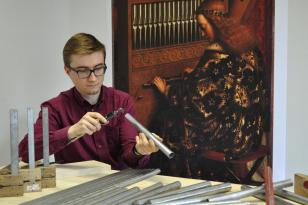This archived website 'Flemish primitives' is temporarily not being updated. Certain functionality (e.g. specific searches in the collection) may no longer be available. News updates about the Flemish primitives will appear on vlaamsekunstcollectie.be. Questions about this website? Please contact us at info@vlaamsekunstcollectie.be.
Exhibition 'Mystical Music' at Caermersklooster
The exhibition ‘Mystical Music' at the Caermersklooster in Ghent highlights the music in the ‘Ghent Altarpiece' by the brothers Van Eyck.
Two panels of the ‘Ghent Altarpiece' show figures that are both seraphic and human. On the panel to the left, between Adam and Mary, singers stand by a lectern with a manuscript. On the panel to the right, between Eve and John the Baptist, somebody is playing a small organ. Two other people, with a harp and medieval fiddle, stand by and watch.
Angels singing and playing music ascend above the earthly, everyday music. They sing and play music that is not audible to the human ear. It is celestial music that humans simply cannot imagine. However, because the angels are depicted in a very human manner, they help to bridge the gap between this inaccessible celestial liturgy and the liturgy that can be heard here on earth.
Vocal music in the Christian church has embraced polyphony. Plainchant formed the basis of the daily liturgy, but part-singing could never be too rich for celebratory occasions.
The singers from the fifteenth century, including those who focused on polyphony, were first and foremost steeped in Latin and Gregorian liturgy. The singing angels depicted by the Van Eycks were undoubtedly this type of singer: they sang both plainchant and polyphony. They were also very familiar with the repertoire of the worldly song, accompanied by the harp and medieval fiddle.
How do we look at fifteenth century music nowadays? Is the organ player accompanying them and will the angels provide support on the harp and medieval fiddle? How can late medieval musical representations inspire musicians nowadays? And how can an instrument maker gain a better understanding of how the organ was played back then?
These questions are addressed throughout the work of instrument maker Andrzej Perz (University College Ghent) and Hendrik Vanden Abeele (Alamire Foundation and Ensemble Psallentes)
Exhibition 'Mystical Music'
From September 10, 2015 until April 3, 2016
Caermersklooster, Vrouwebroersstraat 6, 9000 Ghent
More info
(News item September 10, 2015)







